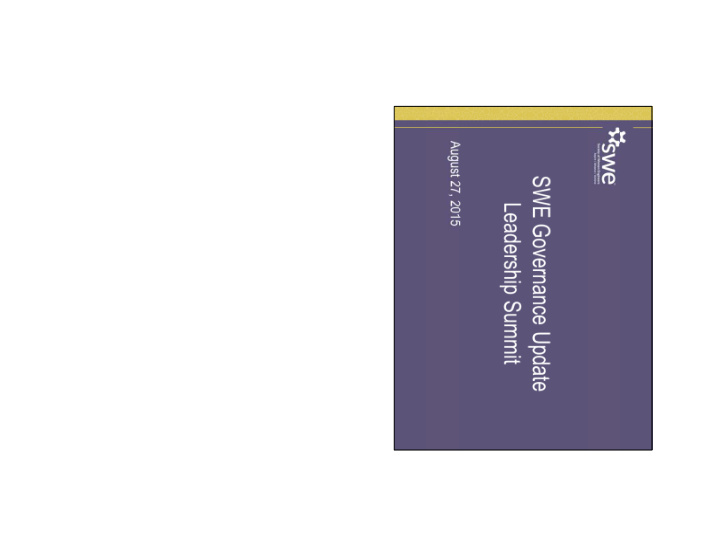



The Society of Women Engineer’s (SWE) current structure and governance are the result of numerous decisions made over a number of years, and these decisions were made with the best intentions and the best information available at that time. Times change, however, and it’s important to periodically step back and look at how things are going and where changes may be needed. With that in mind, in October 2014, the SWE Board of Directors (BOD) engaged a consultant to help determine the ideal governance structure and volunteer service model to support the organization’s growth and globalization goals and to maximize member engagement. A Funding Request was submitted to the Special Project Reserve for this purpose. The Funding Request stated in part: “The organization is currently at an important stage in its growth as it looks to expand its reach globally and effectively serve members both domestically and abroad. SWE has also struggled in recent years with developing and maintaining a successful leadership pipeline to identify and engage volunteer leaders at all levels of the organization. The existing governance structure, while it has been effective for the organization in the past, has been perceived to be a limiting factor in both attracting volunteer leaders and sustaining the future growth of the organization.” A small task force was established to work with McKinley on activities, review recommendations, and provide feedback. The task force consisted of those listed. 2
Development of a flexible SWE governance structure that supports globalization and inclusion is a strategic objective that supports a key Society strategic goal. As such, the primary goals of the effort were to evaluate SWE’s current governance structure, benchmark comparable organizations, and develop: • New, clearly-defined roles and responsibilities for volunteer leadership, which ensure that volunteering to serve is an attractive and smooth process, • An appropriate process to identify, select and engage volunteers who can effectively lead the organization, • A framework for succession planning and cultivation of new leaders, and • Analysis and recommendations on potential adaptations of SWE’s leadership structure for sections, regions and committees; strategies for ongoing leadership and staff training; engagement opportunities that are appropriate given member preferences; and processes to ensure leaders are focused on and having an impact on critical association decisions. 3
McKinley Advisors was chosen to conduct the research and investigation and develop recommendations. McKinley works exclusively with associations and has specific experience providing this type of service, including enacting new governance and leadership models for other non-profit organizations and optimizing organizational performance. Their clients include American Institute of Architects, Pennsylvania Institute of CPAs, American Association of Engineering Societies, and American Society of Civil Engineers. 4
McKinley reviewed available data and conducted benchmarking to evaluate other organizations’ effective governance and engagement to the extent applicable, and included National Society of Professional Engineers (NSPE), Institute of Electrical and Electronics Engineers (IEEE), and American Institute of Architects (AIA),. In-depth interviews with SWE staff and volunteer leaders focused on SWE’s governance and volunteer opportunities, to gain insight on perceptions of and experiences with the governance structure, assess the strength and challenges of the current governance model, and identify opportunities for SWE to create a more effective, inclusive model to attract and retain current and future leaders. Interview participants were from across the country and the globe, and were primarily long-term SWE members with average membership tenure of 20 years, and included several SWE Fellows. All had served at the Section level, many in multiple positions, as well as on a committee or special task force, in regional or Senate positions, and/or as past or current BOD members. McKinley also facilitated in-depth discussions with the Senators and Regional governance teams. Based on this, McKinley proposed a number of recommendations and options to optimize SWE’s governance structure. These recommendations will be reviewed in more detail in the coming months by sub-teams in order to thoroughly vet the ideas and develop specific implementation plans. Included is a Board contact for each area. 5
Refer to more detailed information in Background Document 6
Refer to more detailed information in Background Document 7
Sub-groups are being formed to take an in-depth look at the recommendations and determine an appropriate path forward, including an implementation timeline. These sub- groups will be staffed with current Senators, Region Governors and BOD members. In addition, input will be solicited from specific long-time SWE members to help identify and overcome potential barriers to success. It was recognized that many of the changes being proposed have interrelated effects on other changes and other parts of the organization. An extensive list of all documents that may be affected is being developed to ensure consistent and coordinated updates. In addition, focus on improving the value, consistency and accessibility of volunteer leadership training, will significantly increase the efficiency and productivity of the governance structure. This will build on the current Leadership Coaching Committee (LCC) model. By facilitating ongoing communication among all levels of the governance structure, SWE will be better positioned to identify opportunities for collaboration and decrease redundancy across the Society. HQ will be evaluating channels for more effective communication throughout the organization. Programs and mechanisms will be developed for ongoing communication from/among sections, the BOD, and HQ, including in-person and virtual town-hall meetings and video updates. 8
Recommend
More recommend